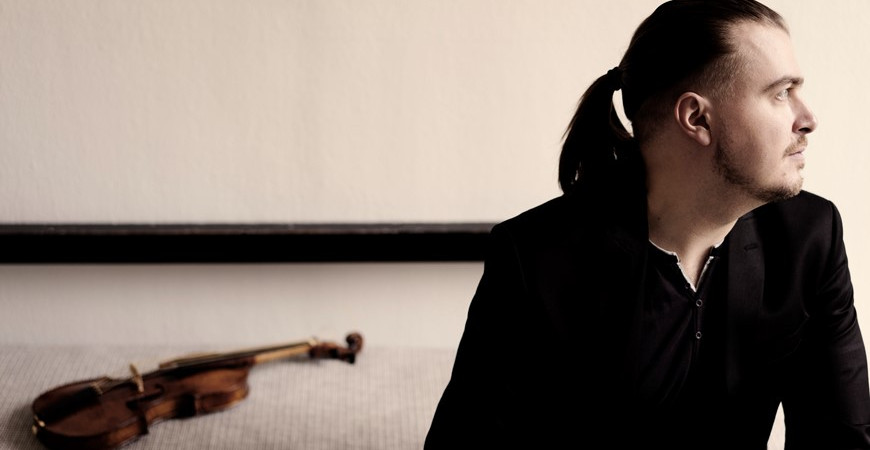From genre to genre, from age to age
Violinist, countertenor, conductor. Dmitry Sinkovsky is one of the most exciting musicians of our day. Although most at home in the Baroque, he actually plays the entire Classical-Romantic repertoire. Irrespective of period or genre, he performs with astonishing vigour and affirmation of life flowing from his music-making. The audience of the Liszt Academy had the chance to experience for themselves the magic of this artist when he accompanied Julia Leznyeva at the head of his ensemble, La Voce Strumentale, last year. This time we can enjoy him as partner of Aura Musicale, led by Balázs Máté.
Your career is far from ordinary, yet it started out this way.
My background might be considered traditional – my violin studies in Moscow followed a well-worn path – but later I took a few decisions that cannot be considered typical: I went to study Baroque music and performing methods, then after a time I started to sing professionally, while now I am taking a course as a conductor at the university of Zagreb. Naturally, as a practicing musician I know a lot about conducting, but it does not hurt to sit down and study the technique of conducting, the movements and the communication mechanism.
You were twenty-four and helping out a professional singer at a rehearsal when you were asked to sing yourself the next day. Was this a revelation or did you know you were a good singer?
Earlier I had sung in a chorus and had always dreamt of a singing career, but this was a genuine shock for me. That evening I really ruined my voice singing, I was so nervous, but then everything turned out fine and I had a lot of luck with my teachers in later years. Today I even sing lead roles in operas. Not long ago I sang the title part in Händel’s Lucius Cornelius Silla at the Händel festival in Göttingen, and next year I will be singing the same role at the Ludwigsburg and Potsdam festivals.
What did you learn from your former teachers, the countertenor Michael Chance and the violinist Marie Leonhardt, wife of Gustav Leonhardt?
Naturally, from Michael Chance early English music literature, the music of Dowland and Purcell, and correct English pronunciation. He was of enormous help in shaping my English repertoire. As for Marie Leonhardt, she introduced me to the world of Baroque at the beginning of my career. She was not so much a teacher as a guide. We went to galleries and talked about architecture and ornamentation. This was also extremely important: to come to know the general art of the age whose music I play.
How far do you consider yourself to be a Baroque violinist?
This is how I was introduced to the market and this decisively defines what people think of me. But I do not consider myself to be a typical Baroque violinist. I played a Shostakovich violin concerto at my diploma concert [...]We are soon to record an album of violin concertos by Beethoven, Brahms and Mozart. Of course, Baroque music is a great love, but I have other loves, too.

In what ways does the Baroque performance mode differ from other periods?
Baroque is a language; indeed, I could say it is a philosophy. Many ask me for the secret, the recipe to Baroque performance. There is none. It is a language that must be learnt in just the same way as a spoken language. If a person really wants to acquire a language, then they must understand the habits, humour, literature and art of the given language area [...] in other words, it is not just about how to play trills in the Baroque repertoire.
As far as you are concerned, what is the essence of historically informed play?
I mentioned that Baroque is a musical language. It has grammar, articulation. And then there are the affects: happiness, sorrow, pain, joy, and so on. But it is extremely important to be pragmatic; Baroque is extremely structured, highly regulated and rich in form, yet it must still be played as the piece requires. Anyway, it is not as though only one type of Baroque exists: the dialects differ, and a person doesn’t play Bach in the same manner as Corelli or Purcell. Baroque is a bit like saying “Europe”. What exactly does “Europe” mean? Moscow, Lisbon, Dublin or Helsinki?
You play on a 17th-century Cremona Ruggieri violin, although it has been restored and modernized on several occasions. Which part is still original?
Its soul! Just imagine, it was made before Bach had even been born! It is in perfect condition. You are right, though, it was restored in the 19th century, and they changed the neck. I’m delighted with it because I am able to use it to play later Classical and Romantic works. Even though certain things are far harder to play on gut strings because they are far more sensitive to humidity. Every string is made by hand. I request 20–30 strings from my Italian supplier, from whom I have been putting in orders for many years, and those that are no good – for instance, the animal from which the string was made was not in a healthy condition – I send back and he replaces them. This is a very tricky matter because, for instance, if the E string does not match the A string, then the sound is damaged. Metal strings are always the same; gut strings are an eternal challenge requiring constant finetuning and adjustment. But the fact is that metal strings only came in in the 1920s, so up until that time everybody played on gut strings. I only switch to metal strings if I play with a grand orchestra.
Judit Rácz


